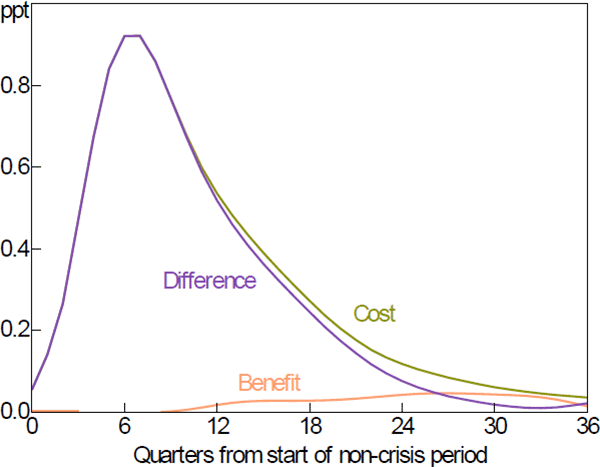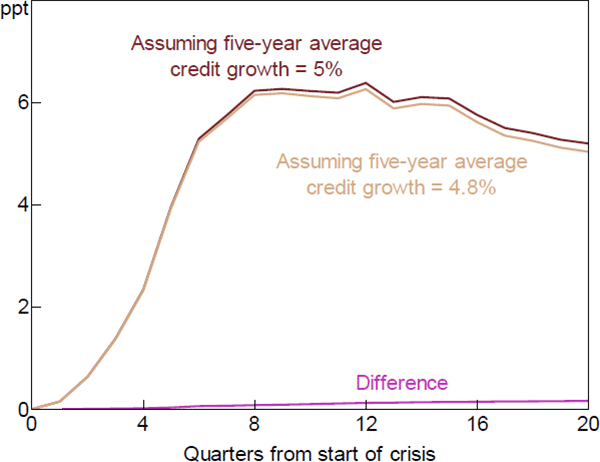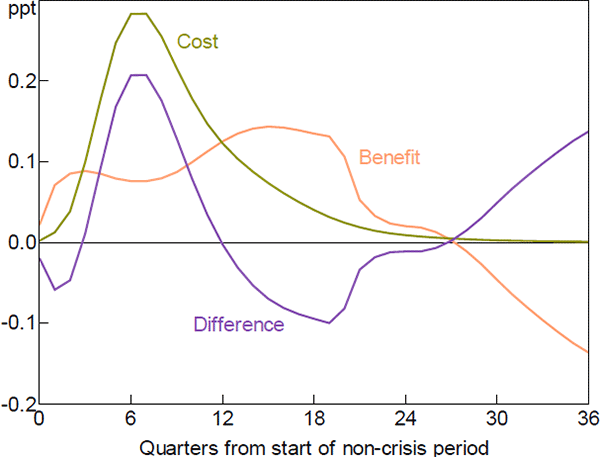RDP 2019-05: Cost-benefit Analysis of Leaning against the Wind Appendix B: Endogenous Crisis Severity
July 2019
- Download the Paper 1,513KB
This appendix discusses how the cost-benefit results change if we assume the severity of a crisis is endogenous, as summarised in Section 5.2.
Svensson (2017a) assumes that a crisis results in a fixed increase in the unemployment gap, so that:
where cbase is now interpreted as the increase in the unemployment gap if a crisis occurs. Starting from a higher initial unemployment gap, , a crisis of a given size results in a higher peak unemployment gap. This means that a crisis is more costly if it occurs when the economy is already weak. This can be interpreted as an additional cost of leaning against the wind.
Gerdrup et al (2017) suggests that the crisis unemployment gap is likely to be smaller if leaning against the wind results in slower credit growth. This is partly based on the work of Jordà, Schularick and Taylor (2013), who find that credit-intensive expansions tend to be followed by deeper recessions. Jordà et al also find that credit-intensive expansions are substantially longer and larger, but we ignore this offset.
The effect of weaker credit growth on the severity of a crisis can be interpreted as an additional benefit of leaning against the wind. If we take into account both of these effects, the effect of leaning against the wind on the expected crisis unemployment gap can be expressed as:
By substituting Equation (B3) into Equation (A6), we have:
Equation (B4) can be separated into the cost of a higher initial unemployment gap (Svensson's assumption) and the benefit of weaker credit growth prior to the crisis (Gerdrup et al's assumption). When we do this, we can rewrite Equations (A3) to (A6) as follows.
where:
To quantify Svensson's argument we set the non-crisis unemployment gap equal to the path shown in Figure 1B and the amount by which the unemployment rate is assumed to increase in the crisis (cbase) equal to 5 percentage points. The sum of these represents a higher unemployment gap in a crisis under leaning against the wind. This raises the cost of the policy as defined in Equation (B6) and shown as the olive line in Figure B1. Benefits, shown as the light orange line, are largely unchanged from Figure 3. Costs are estimated to be almost 30 times larger than the benefits, the entry in Table 2, row 2.

Figure B2 shows estimates of the increase in unemployment in a crisis for different assumptions about real credit growth over the previous five years, based on Gerdrup et al (2016, Table A3).[18] The dark red line assumes real credit grows at 5 per cent per year, as in our baseline. The light brown line assumes real credit grows 0.2 percentage points less each year, consistent with the effect of leaning against the wind shown in Figure 1C. Although Gerdrup et al's estimates indicate that credit has potentially large effects on crisis severity, the difference between the lines in Figure B2 is small, reflecting that interest rates have small effects on credit growth.

Sources: Authors' calculations; Gerdrup et al (2016)
We combine these estimates with our other parameters and Equations (B6) and (B7) to get overall costs and benefits as shown in Figure B3. Comparing this with Figure 3 shows that letting credit growth affect crisis severity substantially increases the benefits of leaning against the wind. However, the net benefit is still negative. This differs from Gerdrup et al, who found that allowing credit growth to affect the severity of a crisis makes leaning against the wind worthwhile. As Svensson (2017b) notes, the ‘black box’ nature of Gerdrup et al's estimates makes it difficult to explain differences. One partial explanation is that Gerdrup et al estimate the effect of credit growth on the probability of a crisis using data for 20 countries over the past 40 years. This provides larger estimates than those based on longer, narrower samples (see their Figure 8). Another partial explanation is that our estimates of the effect of interest rates on the unemployment rate are larger. This may reflect differences between Australian and Norwegian data. Svensson (2017b) provides more detailed comparisons of Gerdrup et al's results with others.

The costs of leaning against the wind far outweigh the benefits when we allow for both of these effects (Table 2; Figure 7). Importantly, taking into account both of these effects results in a larger expected welfare loss than in the baseline scenario. In other words, the increased costs from a higher initial unemployment gap are (much) larger than the benefits associated with a slower pace of real credit growth.
Footnote
These estimates differ from those shown in Figure 2 from Gerdrup et al (2017, Figure 1), reflecting small updates (which we do not incorporate) and different baseline credit growth for Australia relative to the OECD. [18]